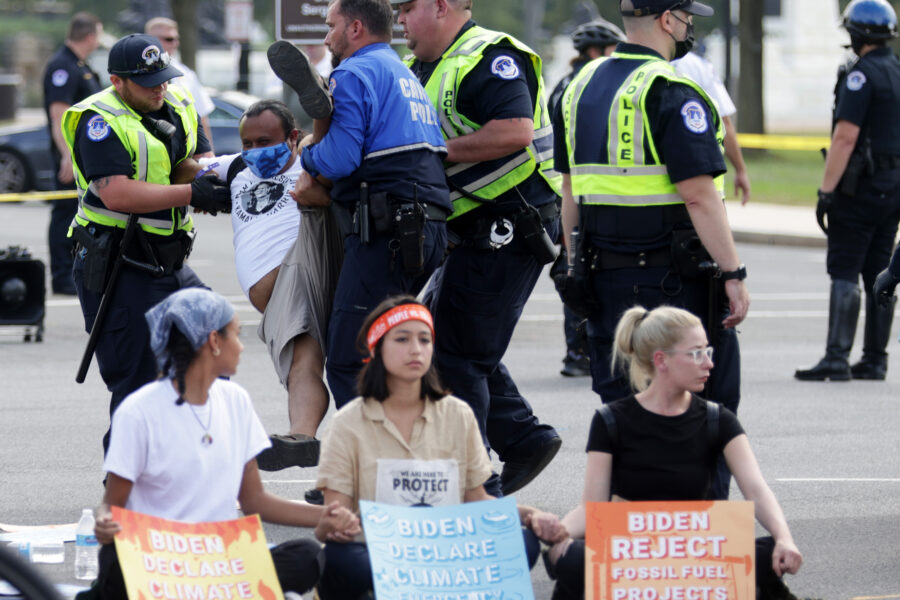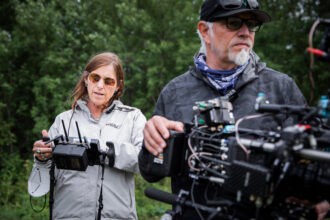Q&A: Maryland’s First Chief Sustainability Officer Takes on the State’s Climate and Chesapeake Bay Cleanup Goals
Meghan Conklin is no stranger to corridors of powers. A California transplant, she cut her teeth in Washington, D.C., where she spent more than 20 years serving in various roles in Congress and the federal government. As a staffer, she assisted committees and legislators on issues such as climate change, environment, and energy policy in Maryland and nationally.
After taking office as Maryland’s first Black governor, Wes Moore created two new positions—chief resilience officer and chief sustainability officer— to advance statewide efforts to confront the adverse effects of the climate crisis. “Addressing the existential threat of climate change requires bold and decisive action,” Moore said in November. “We must think strategically and we must address our present challenges to prevent future effects.”
He appointed Conklin to be the state’s first chief sustainability officer—a challenging role that requires her to work with federal, state, local and private partners to ensure that Maryland meets its bold climate and environmental targets, such as reaching net-zero emissions by 2045. She will serve on the governor’s planned climate subcabinet and Chesapeake Bay Cabinet, developing and implementing climate-related policies, regulations, and programs.
Two months into her new position, Inside Climate News sat down with Conklin for an interview and asked her, among other things, what it means to be Maryland’s first chief sustainability officer. This interview has been edited for length and clarity.
We’re hiring!
Please take a look at the new openings in our newsroom.
See jobsWhat got you into your line of work?
I’m actually from California and lived in Washington, D.C., for 25 years, right on the D.C.–Maryland border but crossed over into Maryland, which is my adopted state now, for the last five years.
I grew up in a family where public service is a big part of who we are. My dad was in the Marine Corps and later in federal law enforcement. It was the same with both of my grandfathers. Being a public servant is a big part of how I grew up and runs in the family.
What motivated you to work on environmental and climate issues?
I went to the University of California, Santa Barbara, and studied environmental studies because I wanted to work on environmental issues. It wasn’t until undergraduate years that I fell in love with Democratic politics. A professor of mine, who has since passed away, ran for Congress and ended up winning. I worked on his campaign and was bitten by the political bug. After finishing undergraduate studies, I moved out to Washington, D.C., intending to work on environmental policy.
Being a proud single parent of two young sons is another big motivation for me to work on climate issues. My kids growing up in this day and age have such more weight on their shoulders than previous generations. They had to go through the COVID pandemic. They see the climate change up close and personal every day. Last year, it was too unsafe for my kids to play outside because of the smoke from the fires from Canada. It affected their summer camp and so we had to have indoor camp for a number of days.

What experience do you bring to your new role?
I worked primarily in the federal government for most of my career. I spent 11 years on Capitol Hill working as a staffer on the House Natural Resources Committee and then on the Senate Energy and Natural Resources Committee. I helped enact the 2009 omnibus bill, the Public Land Management Act, and also worked on creating new national parks. Later on, I worked for Maryland senator Chris Van Hollen for a number of years and helped him with the early drafting of the climate provisions in the Inflation Reduction Act. Now I have the opportunity to assist the state in implementing those policies, which is really fulfilling. It’s wonderful to be in a Democratic supermajority with a Democratic governor, a different scene than I’m used to, in D.C., but in a really exciting way.
Being the first chief sustainability officer for Maryland, what is your vision?
I was interviewed for the position over the course of a number of months and it was truly an honor to eventually get the call and offered the role.
My main goal is to make sure that Maryland meets its bold climate and environmental goals.
There are three big issues Governor Moore has asked me to work on. The first one is climate change. Here in Annapolis, we’re just down the street from the Chesapeake Bay, which is one of the special places I’ll be working on to protect.
The other big thing I’m focused on is to make sure that Maryland continues to tap into the federal funds since I spent so much time in the federal government. I helped Senator Van Hollen draft two substantial climate provisions in the IRA including the $8.8 billion in rebates for homeowners to make their homes more energy efficient and switch to electric appliances. And $137 million of that is coming to Maryland.
I also sit on our federal investment team, which comprises federal and state level political and career staff. We compile updates on the status of the various applications for funding under the IRA and the Bipartisan Infrastructure Law (BIL). Maryland has been allocated $12.6 billion under the IRA and the Infrastructure Law and we’re really excited about that. We’re also weighing a partnership between the U.S. Department of Energy’s Loan Program Office and the Maryland Clean Energy Center, which is our state green bank, to leverage IRA funds.
I will also be working with the General Assembly to figure out the long-term funding for the state’s climate plan and I remain optimistic that we will get there.
As chief sustainability officer, who else will you work with?
I work under Shaina Hernandez, one of our deputy chiefs of staff, who previously worked in Howard County government and for the former Maryland Governor Martin O’Malley. I also work closely with different state agencies working on climate issues. Also, plans are afoot to set up a sub-cabinet on the climate soon that will include all the people across agencies who work on climate to make sure that there is a coordinated effort to meet our climate targets. A lot of what I’m doing involves coordinating amongst various state agencies.
What are some of the near-term goals you intend to focus on?
Governor Moore has taken the leadership of the Chesapeake Executive Council, which consists of the governors of the six watershed states, the mayor of the District of Columbia, the chair of the Chesapeake Bay Commission and the administrator of the U.S. Environmental Protection Agency. It’s a really important role and I’ve been working with the secretary of the Department of Natural Resources, Josh Kurtz, to chart a new course on Bay conservation and get everyone in the watershed back on track to meet our pollution reduction goals. You may know that the Chesapeake member states reached an agreement on reducing Bay pollution a number of years ago, and the goals of that agreement are right around the corner. And we also have to figure out what our goal for the watershed should be beyond 2025 because so much has changed in the Bay, particularly with climate change. That’s one big thing on my plate.
Are the Bay’s 2025 goals still achievable?
During the Trump administration, we saw zero leadership coming from the EPA’s then-administrator, Scott Pruitt, and his deputy, Andy Wheeler, who’s now working for the governor of Virginia. They tried to zero out all funding for the Chesapeake Bay and viewed the Bay pollution reduction goals as merely aspirational. The current EPA region 3 administrator Adam Ortiz is doing a wonderful job in his position. I think what we’re hoping to do in our new leadership role is to help set new goals for the Chesapeake Bay. And so we’re starting those conversations over the course of this year led by the DNR Secretary Josh Kurtz. I think that Maryland can lead other states sharing the watershed in a better direction going forward.
The state is also faced with a budgetary shortfall. Does that impact your ambitions?
My hope is that over the course of the next year, we will work in partnership with the General Assembly and figure out what the long-term solution could be. I’m not going to say that I know what it’s going to be at this point. I think it’s going to involve a lot of discussion and figuring out and bouncing various opinions on the best way for Maryland to get to a better fiscal situation. But I do feel like we’re showing that there is the will to get there, which is an important first step.
Are there any bills before the General Assembly that can help confront some of the climate challenges Maryland is facing?
There are a number of bills in the General Assembly we have shown our support for. There’s a bill to reform Empower Maryland, the state’s energy efficiency program. The governor is lending his support to that bill. On the Chesapeake Bay, there is a bill by Senator Sarah Elfreth and Delegate Sara Love called the Whole Watershed Protection Act, which would implement the recommendations by the Scientific and Technical Advisory Committee of the Chesapeake Bay Program. We have announced our support for that bill. I will continue to do my best to meet with various climate champions in the state legislature about ways that I can support their efforts.
There’s a bill winding through the General Assembly seeking to eliminate trash incineration from Maryland’s renewable portfolio standard. Is the administration supporting that bill?
We’re still taking a look at that bill. Governor Moore has said a number of times he wants to reach 100 percent clean energy by 2035. And he’s particularly interested in shoring up Maryland’s offshore wind capability. So I’ve been in early discussions with the Bureau of Ocean Energy Management about the next round of the sales in the mid-Atlantic region. We hope to continue work with the Biden administration on offshore wind as well. Obviously, there are significant challenges on the supply side and on the transmission side that I want to spend a lot more time diving into. Maybe next time when we talk I can talk more in depth about it.
What would you like to achieve in the next year?
The big thing is to make sure that we continue to do everything we can in Maryland to implement the Climate Solutions Now Act. I’ll be working to make sure that each agency involved is doing its part to implement its various sections and getting the rulemaking done that needs to be issued as part of our climate commitments. For example, we’ve got building electrification standards and clean heating standards that the Maryland Department of the Environment needs to issue.
I will also work over the course of the next year with the General Assembly to figure out the funding question. And then, as I mentioned, working with the Department of Natural Resources on taking the leadership role on the Chesapeake Bay and rethinking what our goals are going to be in 2025 and beyond in the bay and get some more momentum back there.
As a political appointee, do you think this position will continue beyond the present tenure?
I feel like we’re setting a good precedent for other governors to take this issue seriously. And there are plenty of other states that have an equivalent of someone in my role. For example, California and New Jersey have established similar roles. I think that more and more states are leaning in to take bold action on the climate crisis and putting someone either in a senior advisor on the climate or as chief sustainability officer.
Share this article
Disclaimer: The copyright of this article belongs to the original author. Reposting this article is solely for the purpose of information dissemination and does not constitute any investment advice. If there is any infringement, please contact us immediately. We will make corrections or deletions as necessary. Thank you.







